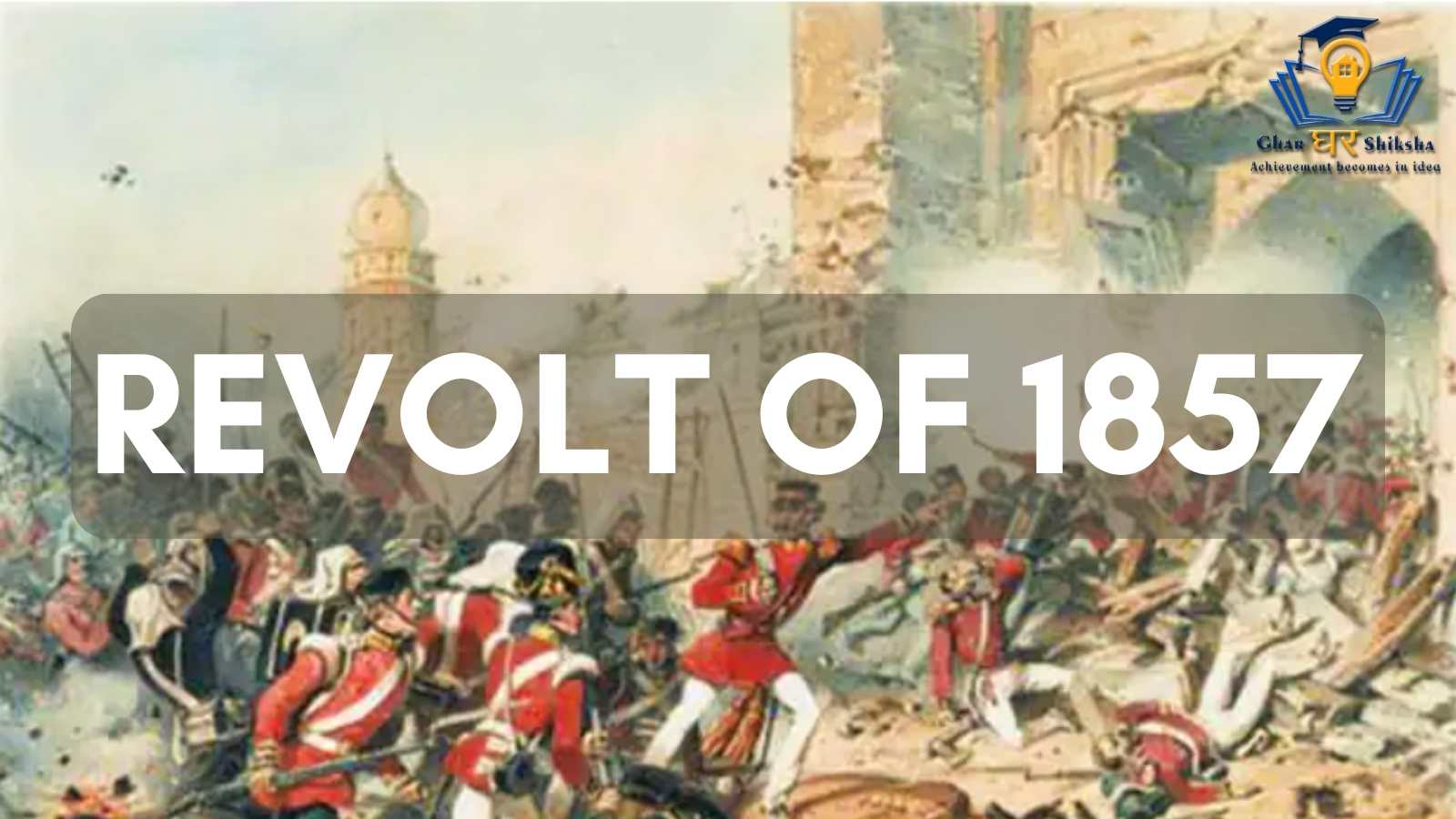The Revolt of 1857, also known as the Indian Rebellion of 1857 or the First War of Independence, was a watershed moment in India’s history. It was a significant uprising against British colonial rule, sparked by various social, economic, political, and religious factors that had been simmering for years. The revolt marked a critical point in India’s struggle for independence and played a crucial role in shaping the nation’s future.
Causes of the Revolt of 1857
- Economic Exploitation: The British East India Company’s oppressive economic policies adversely affected the Indian peasantry and artisans. Heavy taxation, exploitative land revenue systems, and the destruction of traditional industries resulted in widespread poverty and deprivation among the Indian populace.
- Discontent among Sepoys: The British Indian Army, primarily comprising Indian sepoys (soldiers), was subjected to discriminatory treatment in terms of pay and promotions compared to their European counterparts. This disparity, coupled with cultural and religious grievances, fueled resentment among the Indian soldiers.
- Doctrine of Lapse: The Doctrine of Lapse, introduced by Lord Dalhousie, allowed the British to annex Indian states if they lacked a male heir. This annexation policy led to the demise of several princely states, further antagonizing Indian rulers and the nobility.
- Religious and Cultural Insensitivity: The British administration’s disregard for Indian customs and religious sentiments, such as the introduction of the Enfield rifle greased with animal fat, which offended both Hindu and Muslim sepoys, contributed to widespread discontent. This was also the immediate cause of the revolt.
- Political Intrigues: The annexation of territories and the subjugation of local rulers created an atmosphere of distrust and fear among Indian aristocrats, fostering a fertile ground for rebellion.
The initiation
The Revolt of 1857 was ultimately triggered by the issue of greased cartridges, causing widespread discontent among the sepoys. A rumor circulated, alleging that the new Enfield rifle cartridges were greased with cow and pig fat. To load these rifles, the sepoys had to bite off the paper from the cartridges, which deeply offended both Hindu and Muslim soldiers. Consequently, they refused to use the rifles.
In an attempt to rectify the mistake, Lord Canning withdrew the offensive cartridges, but the damage had already been done, leading to unrest in various regions. In March 1857, Mangal Pandey, a sepoy stationed in Barrackpore, rejected the use of the cartridges and launched an attack against his senior officers. His actions resulted in his execution on April 8th.
Another incident occurred on May 9th when 85 soldiers in Meerut also refused to employ the new rifles and were subsequently sentenced to ten years’ imprisonment. These events marked the beginning of a series of events that culminated in the Revolt of 1857.
On May 10, 1857, troops in Meerut began the Revolt of 1857.
Major centers of the revolt and their leaders |
|
| Delhi | Bahadur Shah II (Mughal Emperor) |
| Kanpur | Nana Sahib, Tantia Tope |
| Lucknow | Begum Hazrat Mahal, Birjis Qadr |
| Jhansi | Rani Lakshmibai |
| Meerut | Sepoys of the 3rd Cavalry Regiment |
| Bareilly | Khan Bahadur Khan |
| Faizabad | Maulvi Ahmadullah |
| Allahabad | Maulvi Liaquat Ali |
| Agra | Rao Sahib |
| Gwalior | Rani Lakshmibai |
| Arrah (Bihar) | Veer Kunwar Singh |
Major Leaders Involved in the Revolt of 1857
- Rani Lakshmibai of Jhansi: Rani Lakshmibai, the Queen of Jhansi, became an iconic figure during the revolt. She fearlessly led her troops into battle and symbolized the spirit of resistance.
- Bahadur Shah II: Bahadur Shah II, the last Mughal emperor, was an elderly and reluctant leader of the rebellion. His endorsement gave legitimacy to the uprising.
- Nana Sahib: Nana Sahib, the adopted son of the deposed Peshwa Baji Rao II, played a pivotal role in the Kanpur uprising and was one of the key leaders of the revolt.
- Kunwar Singh: Kunwar Singh, a notable leader from Bihar, inspired many to join the rebellion in the northern regions of India.
- Mangal Pandey: Mangal Pandey, a sepoy in the British Indian Army, is often regarded as the catalyst for the revolt. He rebelled against the use of the greased cartridges and was subsequently executed.
Consequences of the Revolt of 1857
- End of the East India Company: The revolt led to the British Crown assuming direct control over India, ending the reign of the British East India Company. The Queen’s Proclamation of 1858 declared equality before the law for Indians, promising to respect their customs and religions.
- Changes in Governance: The revolt necessitated administrative reforms, including the appointment of a Secretary of State for India and the establishment of the Indian Civil Service, which allowed Indians to participate in the administration.
- Indian Nationalism: The revolt awakened a sense of national consciousness and identity among Indians. It sowed the seeds of Indian nationalism, as people from different regions and backgrounds came together to resist British domination.
- Impact on Land and Agriculture: British policies underwent certain changes, and efforts were made to protect the rights of peasants and landlords, though agrarian problems persisted in the later years.
- Religious and Social Reforms: The revolt highlighted the importance of religious unity and led to the initiation of social reforms aimed at eradicating divisive practices within Indian society.
Limitations of the Revolt of 1857
- Limited Coordination: The uprising lacked centralized leadership, resulting in fragmented efforts and a lack of coordination among the rebel forces.
- Regional Disparities: The revolt remained localized to certain regions, and the lack of widespread participation limited its overall impact.
- Class and Caste Divide: The revolt predominantly involved the upper-caste elites, leaving out the marginalized and oppressed sections of society.
- Military Superiority of the British: The British military’s superior weaponry, organizational structure, and tactics gave them a strategic advantage over the Indian rebels.
- Religious Differences: The revolt failed to bridge the religious divide completely, with some Muslims and Sikhs siding with the British against their Hindu counterparts.
Significance for India
The Revolt of 1857 had a profound impact on India’s struggle for independence and the subsequent course of its history.
- National Awakening: The revolt stirred a sense of collective identity and national consciousness among Indians, fostering the idea of unity against British imperialism.
- Struggle for Freedom: It marked the beginning of a long and arduous struggle for independence, inspiring generations of freedom fighters and leaders to carry on the fight against British rule.
- Political Consciousness: Indians began to actively participate in the political process, demanding representation and a voice in governance.
- Reforms and Policy Changes: The revolt led to significant changes in British policies and administration, granting some concessions to the Indian population and introducing reforms.
- Cultural and Social Reforms: The revolt triggered introspection and led to efforts to reform regressive practices within Indian society.
Whether revolt of 1857 was the first war of independence of India or not?
The Revolt of 1857 as the First War of Independence of India:
- National Uprising: The Revolt of 1857 was a significant uprising against British colonial rule and marked the first instance of a united effort by Indians from diverse backgrounds to challenge foreign domination. It sowed the seeds of national consciousness and unity, laying the foundation for subsequent independence movements.
- Pan-India Resistance: The revolt spread across various regions of India, involving people from different religious, cultural, and social backgrounds. It showcased a collective resistance against the British, reflecting a nascent sense of Indian identity.
- Symbolic Leadership: The leaders of the revolt, such as Bahadur Shah II, the last Mughal emperor, and Rani Lakshmibai of Jhansi, were significant figures who represented the idea of Indian sovereignty and were seen as the symbols of resistance against British rule.
- Motives for Independence: The rebels were driven by a desire to regain control over their land, culture, and traditions, as well as to restore the dignity of Indian rulers and nobility. This resonates with the aspirations of an independent nation.
Revolt of 1857 was not the First War of Independence of India:
- Lack of Unified Vision: While the revolt had widespread participation, it lacked a centralized leadership and a unified vision for an independent India. Many princely states and sections of society did not actively participate in the uprising, limiting its scope.
- Regional and Limited Nature: The revolt remained confined to certain regions, and its impact varied significantly across different parts of the country. It did not engulf the entire Indian subcontinent in a unified struggle for independence.
- Role of Princely States: Some Indian princely states remained loyal to the British, either due to political considerations or due to the fear of losing their privileges if they supported the rebellion.
- Support from Other Nations: The revolt did not receive significant support from other countries or nations. An independence struggle typically requires international recognition and support to be considered a war of independence.
- Limited Political Agenda: The objectives of the revolt were largely aimed at restoring the status quo before British annexations and implementing some administrative reforms. There was no explicit call for a completely independent and unified Indian nation.
The Revolt of 1857 was a turning point in India’s struggle for independence. It was a result of numerous grievances accumulated over decades of British colonial rule. While the uprising did not achieve its immediate goal of overthrowing British rule, it left a lasting impact on the Indian psyche, inspiring subsequent generations to fight for freedom and independence. The revolt played a crucial role in shaping the trajectory of India’s nationalist movement and eventually led to the end of British colonial rule in 1947. Though limited in its scope and effectiveness, the revolt’s significance remains indelible in India’s history.
Commentary on the Revolt of 1857
Dr. S.N. Sen- “the uprising started as a fight for religion but concluded as a war of independence.” Famous historian”
Dr. R.C. Majumdar- “it was neither the first nor a national or an independent war. The 1857 Revolt is viewed by the British as only a sepoy revolt by peasants”
BOOKS WRITTEN ON THE REVOLT OF 1857 |
|
| Book Title | Author |
| The Indian War of Independence | Vinayak Damodar Savarkar |
| Rebellion, 1857: A Symposium | Puran Chand Joshi |
| The Indian Mutiny of 1857 | George Bruce Malleson |
| Great Mutiny | Christopher Hibbert |
| Religion and Ideology of the Rebels of 1857 | Iqbal Hussain |
| Excavation of Truth: Unsung Heroes of 1857 War of Independence | Khan Mohammad Sadiq Khan |




